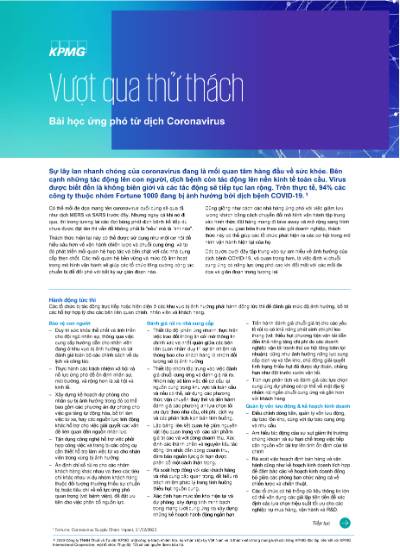Beyond immediate actions, organizations should use this as an opportunity to reflect on the ability to navigate a crisis and, going forward, consider actions to increase agility and become more resilient in the future.
Scenario planning
- Organizations must act with imperative when developing and implementing enhanced risk management practices, focusing on the opportunities scenario planning offers in creating pre-emptive action plans.
- Scenarios enable organizations to see the bigger picture and make effective trade-off decisions on issues like: how much stock to hold – and where, or how to balance the cost of inventory versus the cost of failing to satisfy customers. Simulations can be run swiftly to identify “sweet spots” between apparently conflicting objectives, based on real-time inventory data, customer demand, and supplier capability. Increasingly enabled by AI and automation, these scenarios can help prescribe rather than just predict.
- By analyzing past events and hypothesizing future threats, organizations are able to identify strategic and concentrated supplies that are at risk in major crises, and most importantly, recognize when current internal risk capacities prove insufficient.
Supplier risk management
- Real-time supplier data such as system performance category alerts and geopolitical events helps manage performance and issue resolution.
- When alerted, proactive measures should be taken by organizations to uncover additional exposure levels by reaching out to suppliers (from tier 1, tier 2 and below) outside of affected regions to identify upstream supply dependencies within their supply chains.
- Further, organizations could benefit from balancing supply and demand and working with internal stakeholders as well as critical suppliers to contractually agree on logistic-based costs and necessary buffer stock, so as to reduce sudden price increases in the face of a crisis.
End-to-end supply chain management
- With an increasing shift to e-commerce, organizations need to ensure their internal supply chains and delivery mechanisms can cope with demand to provide the highest quality customer experience.
- This can be achieved with comprehensive end-to-end supply chain management, alongside advancing their ability to model and predict consumer behavior, especially in times of uncertainty and disruption.
Micro supply chains
- Supply chains’ historic focus on reducing costs has led to the creation of large, integrated, global networks, which gain economies of scale through outsourcing manufacturing to emerging economies, backed by long term contracts. However, impacts such as pandemics and increasing trade tensions are forcing organizations to question if this is the right operating model.
- Alternatively, many organizations could benefit from evolving their operating model and shifting towards micro supply chains. Micro supply chains are finite, agile “mini operating models” with flexible contracts and manufacturing closer to the point of purchase. This would leverage their highly flexible decentralized nature and ability to alter production and delivery, scale volumes and introduce new products at short notice.
- By adopting a decentralized approach, micro supply chains create as much value as close to the customer as possible, allowing organizations in times of crisis to benefit greatly from their independence.
- In addition to pandemics, micro supply chains are less vulnerable to other macro phenomena like volatile interest and exchange rates, tax regime change, trade tariffs and quotas, wage inflation and crop failure.
- In fact, companies that prioritized growth, innovation, and risk management in their supplier relationships, instead of just price reductions, achieved savings 26 percent higher.1
Collaborative supplier relationships
- For companies fulfilling mass demand from Chinese-based operations, it is unrealistic to completely exit the Chinese market because of the scale and quality of supplier ecosystems in place.
- However, this crisis can be used as a platform, with time and investment, to build a foundation of trust and transparency that leads to more collaborative relationships with critical suppliers. It is the shared visibility into the goals, motivation and limitations of partnerships that can build organizational resilience.
Technology upgrades
- In line with the technology-enabled business climate we currently operate in, organizations should rethink the way their employees collaborate with each other and customers - within the office, regionally and globally.
- By investing in internal technology, organizations can teach employees how to effectively leverage powered execution tools such as cloud-office technology and zero-touch models. This will help ensure that not only in times of crisis are teams better equipped to work remotely, but as the business environment continues to shift, employees are able to adapt alongside it and continue serving customers.
Network security response plans
- WHO is aware of suspicious email messages attempting to take advantage of the 2019 novel coronavirus emergency. This fraudulent action is called phishing. Using this method, criminals can install malware or steal sensitive information.
- For more from WHO: Beware of criminals pretending to be WHO
Ross Macallister
Managing Partner, Head of Consulting
KPMG in Vietnam
+84 (28) 3821 9266 Ross
Macallister
Phone number
Nguyen Tuan Hong Phuc
Partner, Head of Customer & Operations Consulting
KPMG in Vietnam
+84 (28) 3821 9266 Nguyen Tuan Hong
Phuc
Phone number
Connect with us
- Find office locations kpmg.findOfficeLocations
- kpmg.emailUs
- Social media @ KPMG kpmg.socialMedia
Truong Hanh Linh
Partner, Head of Risk Consulting | Head of ESG Consulting
KPMG in Vietnam
+84 (28) 3821 9266 Truong Hanh
Linh
Phone number
COVID-19 War Room Operations
KPMG offers assistance to businesses affected by disasters with a team comprising of Project Management, Business Continuity, Sourcing, Contract Management, Supply Chain, Risk Management and Data Scientist professionals who have hands-on experience in War Room operations.





